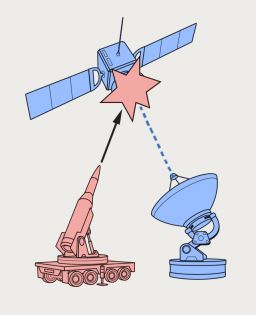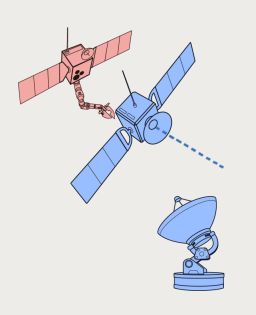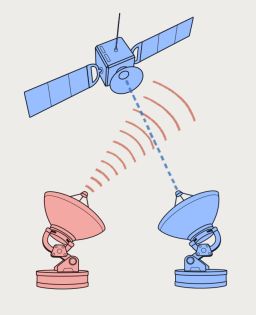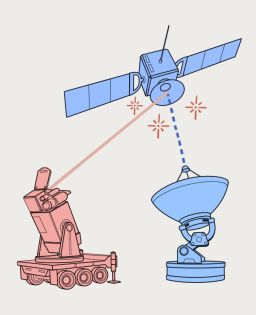Hong Kong
CNN
—
As Russian forces rolled over the Ukraine border within the first moments of their invasion, one other, much less seen onslaught was already underway – a cyberattack that crippled web linked to a satellite tv for pc communications community.
That tech offensive – carried out by Russia an hour earlier than its floor assault started in February 2022 – aimed to disrupt Kyiv’s command and management within the pivotal early moments of the conflict, Western governments say.
The cyberattack, which hit modems linked to a communication satellite tv for pc, had far-reaching results – stalling wind generators in Germany and slicing the web for tens of hundreds of individuals and companies throughout Europe. Following the assault, Ukraine scrambled for different methods to get on-line.
For governments and safety analysts, the cyberattack underscored how satellites –– which play an more and more essential position serving to militaries place troops, run communications, and launch or detect weapons – can develop into a key goal throughout conflict.
As nations and corporations construct out satellite tv for pc constellations, a rising variety of governments are vying for expertise that might disrupt and even destroy adversaries’ belongings – not simply on land, like Russia’s alleged cyberattack – however in area too.
Enter sign jamming and spoofing, high-powered lasers to dazzle imaging sensors, anti-satellite missiles and spacecraft with the capability to intervene with others in orbit – counterspace applied sciences that analysts say main powers like the USA, Russia and China may use to focus on one another’s satellites.
An excessive instance of a possible counterspace weapon was thrown into the highlight earlier this 12 months when US intelligence prompt, in response to CNN reporting, that Russia was trying to develop a space-based, anti-satellite nuclear weapon – a declare Moscow has denied.
Removed from solely affecting military-use satellites, such a weapon may have broad, devastating impacts – for instance, upending satellites the world depends on to foretell the climate and reply to disasters, and even doubtlessly affecting world navigation techniques used for every part from banking and cargo delivery to hailing a journey share and ambulance dispatch.
Final week, the US accused Russia of launching a satellite tv for pc “presumably able to attacking others in low Earth orbit,” with American officers saying it follows prior Russian satellite tv for pc launches of seemingly “counterspace techniques” in 2019 and 2022.
Monitoring nations’ growth of counterspace capabilities is tough, given their intently guarded nature and the twin use ambiguity of many area applied sciences.
Each Russia and China have superior their growth of tech that could possibly be used for such functions in recent times, whereas the US builds on associated area analysis and capabilities, in response to specialists and open-source stories.
Growth of counterspace applied sciences is enjoying out amid a brand new period of concentrate on area – the place the US and China are competing to put astronauts on the moon and construct analysis bases there and advances in satellite tv for pc launch expertise imply a rising variety of actors, together with US adversaries like North Korea and Iran, are placing belongings in orbit.
And as geopolitical rivalries mount on Earth, specialists say Beijing and Moscow are more and more serious about discovering methods to disclaim the US – because the nation with probably the most ground-based capabilities linked to area – the power to make use of them.

The concept of weapons aimed toward or positioned in area stays extremely controversial, however it isn’t new.
A long time in the past, the US and the Soviet Union vied for applied sciences to knock-out one another’s satellites, with Russia’s 1957 launch of Sputnik – the world’s first synthetic satellite tv for pc – rapidly adopted by US counterspace checks.
For the reason that fall of the Soviet Union, America has develop into the pre-eminent energy in terms of capabilities in area linked to conducting navy operations on Earth, analysts say – a energy Russia and China have hoped to show in opposition to it to even the battlefield.
“Growing counterspace capabilities corresponding to (anti-satellite) weapons supplies a method to disrupt your adversary’s space-based capabilities, whether or not it’s communication, navigation, or command and management techniques and logistics networks that depend on space-based techniques,” stated Rajeswari Pillai Rajagopalan, director of the Heart for Safety, Technique & Know-how on the Observer Analysis Basis in New Delhi.
“Denying the US any benefit it might have from using area in a standard navy battle is what’s driving Russia and China by way of their functionality growth and methods,” she stated.

To this finish, Russia is believed to have dusted off Chilly Warfare-era anti-satellite analysis applications, corresponding to for the event of an “aircraft-borne laser system” to disrupt imagery reconnaissance satellites, in response to an annual report by the unbiased US-based Safe World Basis (SWF) launched in March.
New proof suggests Russia can also be working to develop on its ground-based digital warfare capabilities with the event of space-based expertise for jamming satellite tv for pc alerts in orbit, stated the report, which is compiled utilizing open-source intelligence.

In recent times, Russia has additionally launched spacecraft that seem capable of surveil overseas satellites – with the excessive velocity of two of those gadgets and solutions others had been capable of launch aerosols indicating they could possibly be weapons checks, in response to SWF.
China introduced its personal counterspace ambitions in 2007 when it launched a missile some 500 miles into area to take down certainly one of its personal ageing climate satellites. The transfer broke a decades-long, post-Chilly Warfare lull in such harmful, “direct ascent” anti-satellite missile testing, and was adopted by comparable operations from the US, India and Russia.
Since then, China is believed by analysts to have carried out a number of, nondestructive missile checks that might advance its capacity to focus on satellites. The latest of these was final April, in response to SWF, although, like others, that was described by Beijing as a missile intercept expertise take a look at.

China can be believed by the US House Drive to be “growing jammers to focus on a variety of satellite tv for pc communications” and to have “a number of ground-based laser techniques.”
Different Chinese language operations in area are tough to explicitly classify as weapons analysis however may have a navy goal, specialists say. These embody satellites that may strategy or rendezvous with others in orbit, corresponding to for help and upkeep functions, just like the Shiyan-7, launched in 2013 and sure outfitted with a robotic arm.
There may be suggestion from inside China of the potential twin use of such expertise. In a 2021 state media interview, Zang Jihui, a Folks’s Liberation Military (PLA) engineer, described China’s experiments with a satellite tv for pc “outfitted with a robotic arm, capable of change orbit and conduct all-round detection of different satellites” as a part of its “anti-satellite capabilities.”
Beijing included safeguarding its “safety pursuits in outer area” as amongst its nationwide protection targets in a 2019 white paper, however has lengthy stated it stands “for the peaceable use of outer area” and opposes an arms race there. SWF says there isn’t a confirmed public proof of China utilizing counterspace capabilities in opposition to any navy targets.
Russia has additionally stated it opposes weapons in area. Each nations in recent times have established navy forces devoted to aerospace, as has the US, which launched its House Drive in 2019 as the primary new navy department since 1947.
US officers have described America as a pacesetter in advancing the “accountable and peaceable use” of outer area. And given its reliance on area for its protection, specialists say the US navy has probably the most at stake in terms of making certain nations don’t use applied sciences in opposition to satellites there – one purpose analysts say the US coverage group has lengthy shunned putting weapons in area.
Amongst all nations, solely non-destructive capabilities like alerts jamming have been actively used in opposition to satellites in present navy operations, in response to SWF.
Because it took down certainly one of its personal malfunctioning satellites with a missile in 2008 after China’s take a look at, Washington has pledged to not conduct such harmful, direct-ascent anti-satellite missile checks, which may generate harmful area particles, and isn’t believed to have an operational program for such capabilities.
It additionally doesn’t have an acknowledged operational program to focus on satellites from inside orbit utilizing different satellites or spacecraft, although it may seemingly rapidly discipline one sooner or later, in response to SWF.

That’s as a result of the US has performed in depth non-offensive testing of applied sciences to strategy and rendezvous with satellites, together with shut approaches of its personal navy satellites and a number of other Russian and Chinese language navy satellites, SWF says.
The US solely has one acknowledged, operational counterspace system – digital warfare capabilities to intervene with satellite tv for pc alerts – and its military is broadly seen to have superior talents to jam communications and capabilities to intervene with sure navigation satellites. It additionally has appreciable analysis on ground-based lasers that could possibly be used to dazzle or blind imaging satellites, in response to SWF, which says there’s no indication these have develop into operational.

Talking in Washington in November, US Chief of House Operations Gen. Probability Saltzman defined why the US felt it wanted to have the ability to counter different nations’ area capabilities. He pointed to what he described as a “kill internet” technique utilized by China’s PLA to reinforce the vary and accuracy of its weapons inside the strategically essential “second island chain,” operating from Japan to Guam.
“That’s all a space-enabled functionality,” Saltzman stated.
And will Beijing resolve to make use of these weapons, “We have now to have the ability to deny (China) entry to the data to interrupt that kill chain in order that our joint forces will not be instantly in goal and in vary contained in the second island chain,” he stated.
In the meantime, issues about potential adversaries’ area actions have pushed US allies, together with France and Australia, to hunt counterspace talents – typically non-destructive methods to intervene with enemy satellites, often called “soft-kill” capabilities, corresponding to lasers to disrupt surveillance and jamming.
Israel has additionally stated it used GPS jamming in its conflict in Gaza to “neutralize” threats, seemingly ground-based efforts to avert missiles that attain their goal utilizing GPS monitoring.
Extra broadly, there was a pattern towards shorter-term-impact measures like jamming, spoofing and cyberattacks that don’t completely injury or destroy a goal, in response to Juliana Suess, a analysis fellow for area safety at London-based protection suppose tank RUSI.
“(Actors) don’t want to speculate an entire lot of cash into manufacturing these large sci-fi sounding anti-satellite weapons – they’ll simply disrupt an entire community by a cyberattack,” she stated.

Greater than 7,500 operational satellites are orbiting the Earth, in accordance to the latest figures from the Union of Involved Scientists (UCS) in Might 2023.
Of these satellites, greater than 5,000 had been US-owned, with most of them industrial. Nearest competitor China – which has been growing its satellite tv for pc launches – had 628, adopted by Russia with fewer than 200, in response to UCS.
Because it invaded Ukraine, Moscow has accused the West of utilizing industrial satellite tv for pc techniques for navy functions and warned that “quasi-civil infrastructure might develop into a official goal for retaliation.”
Russia has additionally been accused of mounting cyberattacks in opposition to the most important industrial satellite tv for pc constellation, American firm SpaceX’s Starlink, which has been an asset for the Ukrainian navy.
In the case of allegations of growing a nuclear space-based weapon, Moscow has slammed the West as trying to “assign to us a sure plan of motion which we do not need.”
A nuclear weapon in area can be a possible last-resort possibility – or hanging sword – for its potential to wipe out a large swath of satellites, albeit indiscriminately.
If Russia is growing such a weapon, its issues about American constellations like Starlink which have proven navy utility are “seemingly a key motivating issue,” in response to Tong Zhao, a senior fellow on the Carnegie Endowment for Worldwide Peace suppose tank in Washington.
One purpose is that as satellite tv for pc constellations proliferate – aided by advances which have made launches in low Earth orbit (not more than 1,200 miles above the planet) cheaper and simpler – it could possibly be tough for an attacker to trigger an impression by merely focusing on a single satellite tv for pc.
In contrast, “employment of such (nuclear) weapons in area may wipe out massive satellite tv for pc constellations, doubtlessly creating long-lasting particles and radioactive remnants that render orbits unusable for navy and civilian functions,” Zhao stated. That, he added, may additionally inflict “an inconceivable setback on the preservation of area as a standard area for future human growth.”
Chinese language scientists have expressed concern a few potential nationwide safety danger of Starlink, with a bunch writing within the peer-reviewed home publication “Fashionable Protection Know-how” in 2022 that “a mixture of sentimental and onerous kill strategies must be adopted to incapacitate some Starlink satellites functioning abnormally and destroy the constellation’s working system.”
It’s unclear whether or not this view displays considering inside the Chinese language authorities.
Chinese language researchers have additionally thought-about the ramifications of nuclear detonation in area, with a separate group at a nuclear expertise institute publishing analysis final 12 months on pc simulations of the impression of such blasts at completely different altitudes, through which they famous there could possibly be potential results on satellites and different plane.

Nuclear weapons have already got a controversial historical past linked to area.
America’s 1962 Starfish Prime nuclear take a look at some 250 miles over Earth broken not less than a 3rd of the 24 satellites working round that point, in accordance to navy paperwork. It additionally knocked out powerlines in Hawaii and turned the sky above it a violent shade of orange for hours. The take a look at, launched from Earth, was a part of sequence to consider the impact of such explosions, together with in opposition to ballistic missiles.
5 years later, nations involved in regards to the heating area race and nuclear standoffs banned the stationing of weapons of mass destruction in area with the 1967 Outer House Treaty, which doesn’t explicitly ban typical weapons in orbit or missiles launched from Earth.
Although a long time outdated, specialists say that treaty – which affirms that area must be used for the good thing about all nations and is endorsed by Washington, Beijing and Moscow – stays a bedrock for a site that lacks in depth worldwide norms to make sure peace.
Its tenets could also be extra related now than ever – however doubtlessly beneath better menace amid a brand new concentrate on navy and area.
Final month, Russia vetoed an effort within the United Nations Safety Council led by the US and Japan to reaffirm the Outer House Treaty rules, together with the duty to not place nuclear weapons in area. The decision would have been the council’s first on outer area and was supported by all different members moreover China, which abstained.
As a substitute, China and Russia, which have lengthy labored collectively to form guidelines round weapons in outer area, pushed for that decision to be broadened to ban the location of any weapons in area.
Utilizing language that appeared to focus on the US, it referred to as on “all states, and above all these with main area capabilities” to stop the “menace or use of power” in area. A second draft decision backed by Russia that included that modification, was rejected by the council final week, with the US calling it “disingenuous.”
Any future efforts to agree on guidelines for area face a sophisticated outlook, specialists say.
For instance, placement in area of a nuclear weapon just like the one Russia is reportedly contemplating would have far-reaching implications on how area is used – and the way weapons are managed, in response to RUSI’s Suess.
“If the Outer House Treaty was damaged in such a means, it might make it even tougher to think about the place multilateral efforts can go from right here,” she stated.











